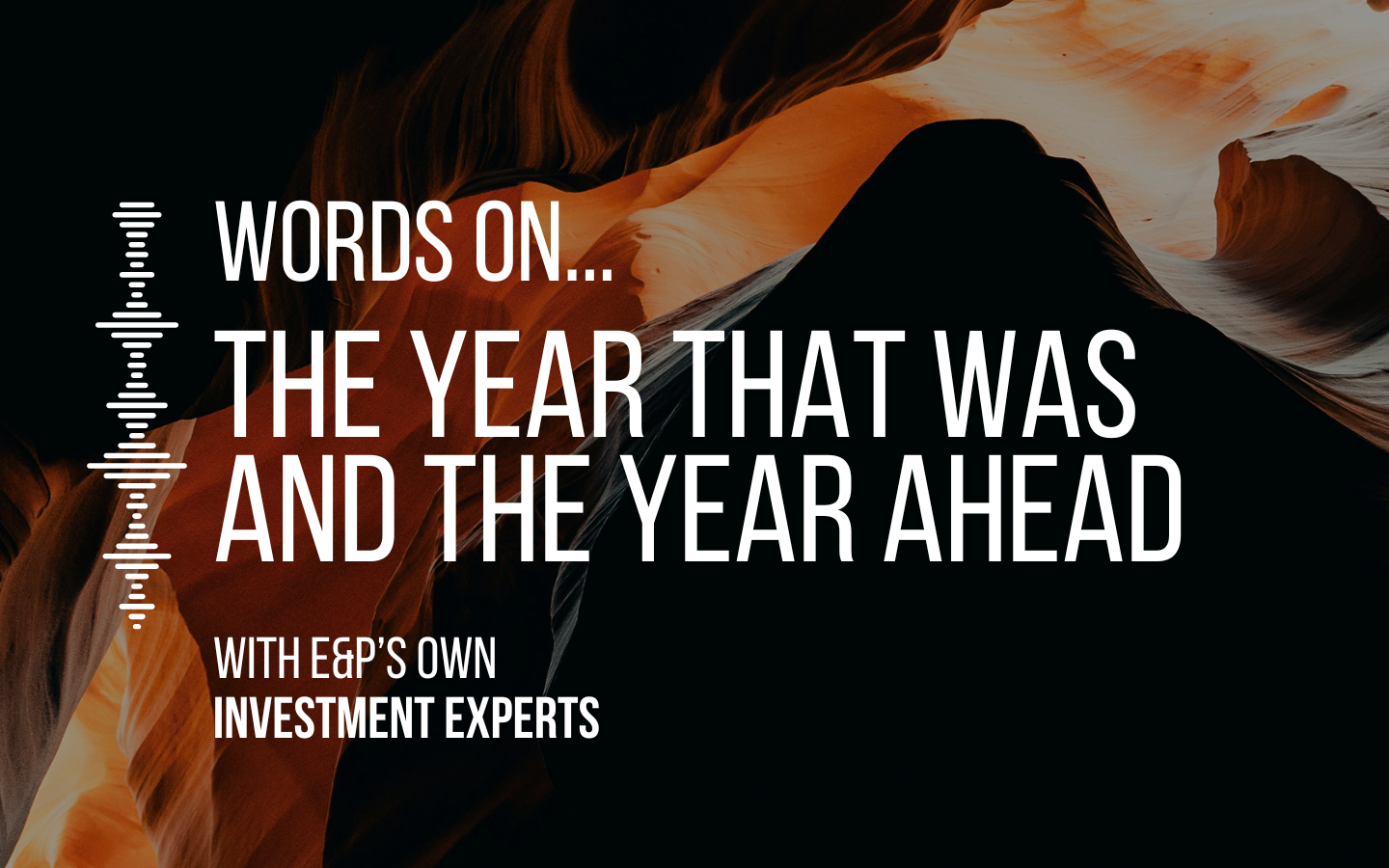


In this episode of Words on Wealth, Chief Investment Officer Tim Rocks speaks with Charter Hall’s Head of Research, Sasanka Liyanage about Australia’s commercial property outlook. They discuss trends across the office, retail, and industrial sectors, the impact of interest rates and supply constraints, and how asset selection will influence returns in a changing market. Tune in to find out more.
This episode is also available on Apple Podcast.
Disclaimer
This podcast was prepared by Evans and Partners Pty Limited AFSL 318075.
Any advice is general advice only and was prepared without taking into account your objectives, financial situation or needs. Before acting on any advice, you should consider whether the advice is appropriate to you. Seeking professional personal advice is always highly recommended. Where this presentation refers to a particular financial product, you should obtain a copy of the relevant PDS, TMD or offer document before making any investment decisions. Past performance is not a reliable indicator of future performance.
Directors, employees and officers of Evans and Partners and its related bodies corporate may have holdings in the securities discussed. Any taxation information is general and should only be used as a guide.
This communication is not intended to be a research report (as defined in ASIC Regulatory Guides 79 and 264). Any express or implicit opinion or recommendation about a named or readily identifiable investment product is merely a restatement, summary or extract of another research report that has already been broadly distributed.
Tim Rocks (00:17)
Hello, welcome to Words on Wealth. I’m Tim Rocks, Chief Investment Officer. With me today, I have SAS, Leon Aguirre, who is Head of Research at Charter Hall. He’s gonna give us ⁓ like a bit of an update really on the property sector. It’s been a challenging sort of few years, but there is certainly the seeds of something interesting growing there. So we’re gonna talk through the main properties of the sectors, perhaps sort of finish with some more niche opportunities just to see really where we are in the sector. So welcome, Sass, and thanks very much for your time.
Sasanka Liyanage (00:54)
Thanks Tim. Thanks for having me.
Tim Rocks (00:57)
Let’s perhaps just begin there with those main ⁓ sectors and perhaps you could just sort of give us an update. Why don’t we start with Office? know, talk to us how valuations have fallen and where we are now.
Sasanka Liyanage (01:12)
Yeah, sure. I mean, it’s a good introduction. Office, much like the other sectors, has been emerging from the largest repricing that we’ve had across the sector since the global financial crisis in 07, 08. And much of this adjustment has been as a result of the rapid rise in interest rates. So, value is in markets had to adjust yields to accommodate for the high borrowing cost. So, Generally speaking, across the market, there was an indiscriminate, we would argue, repricing across all the office sector. know, yields were adjusted between 180 to 220 basis points on average. Where we did see the differentials ⁓ on valuation outcomes was the ability for certain markets to have strong rental growth, which offset the impacts from the adjustment in yield. So in markets like Brisbane, for example, over the past two years, we’ve had substantial rental growth. So we had a far lower adjustment in devaluations. So that was typically between five to 12%. ⁓ In Sydney and Melbourne, had, unfortunately, supply coincide in with the pandemic and the rapid rise of interest rates. So prior to the pandemic, had vacancies in around 3 % in both these markets. And then we had significant supply, which just took place and completed during the pandemic. So that certainly wasn’t helpful for those markets. So Melbourne in 2020, we had the largest year of supply that we’ve had since 1990s. And that was just an unfortunate coincidence. Since then, both these markets have been adjusting pretty well, you’d argue. And now we’re seeing some green shoots and some pretty strong and formidable rental growth coming through both those markets.
Tim Rocks (03:18)
Okay, so you’re feeling as though the bottom has been reached at least for Sydney now?
Sasanka Liyanage (03:24)
Yeah, well, yeah, Sydney, I’d say later last year and Melbourne, the Eastern core this year. But if we’re talking peak to profit in the office markets, we’re typically talking from mid 2022 to late 2024. And it’s first half of the year, we’ve been seeing positive territory across the office markets. So Sydney and Melbourne typically that devaluation in that period was probably around 18 to 30 % and on what assets you looked at. And then obviously the Metro markets, they’re a bit more challenged. And ⁓ we think as we go forward, that recovery now is going to diverge by the quality of your asset. We’ve already seen that and your location and the quality of your portfolio. So that’s certainly the trends that we’re seeing from valuations taking place across that office market.
Tim Rocks (04:17)
Okay, so if you’re careful by the quality of your asset, and the city you think you’ve actually the bottom in valuations is in and there’s decent rental growth from here.
Sasanka Liyanage (04:28)
Yeah, well, mean, you know, it’s this perception of us reality thing in the office markets, right? We’re actually getting, if we look across all the sectors, the office market now represents the strongest rental growth. And we’ve been across the national markets over the past quarter, we saw the strongest rental growth that we’ve seen since 2018. And it is just brought a discussion and we’ll probably talk about in this podcast, but this reality of economic rents or high building costs have moved from a hypothetical to a reality. And now we’re seeing it in the numbers across particularly that office.
Tim Rocks (05:09)
Yeah, so that’s pretty interesting. So that’s one factor. Perhaps it’s part of the poor period of the last few years and also the combination of rising building costs means that future supply is going to be pretty limited.
Sasanka Liyanage (05:22)
Yeah. I mean, it’s coming off a cliff to be fair. And, you know, lot of the supply shock that we had in peak supply was probably 2022 across the markets, but those are developments that were commenced years in advance. Right. And that was, that was pre pandemic. You know, we, we often cite one of our developments here for those in Sydney CBD, we’re building a new chiefly tower. we completed the purchase of that in around 2018 and we’re going to complete the development in around, ⁓ 2028. So it takes 10 years from start to finish to get through a planning process and build something. Now, even more so than in the past, we’ve got construction challenges due to the lack of availability in those labor intensive sectors like office and retail, it’s incredibly difficult to get the appropriate staff to get something stacked up, particularly where there’s union intervention. And in CBD offices, there’s a high level of union intervention in there. And we talked about that correction rents and we talked about borrowing costs increase in, and then obviously yields increase. so, you know, since the start of the pandemic to where we are today, construction costs are 25 to 40 % higher than where they were in the office sector. Then we’ve had obviously borrowing costs go up. your cost of capital has gone up. And so… we need an adjustment either in rents or costs of construction that come down in rapid way. ⁓ We don’t expect the cost of construction to come down or collapse anytime soon, given the labor market is very tight and given the stickiness of that component of construction. ⁓ So there has to be an increase in rents. you know, just throwing some rough numbers out there when we’re looking through our portfolios, the replacement cost of office assets up between 25 to 45 % above existing values. So it’s just not feasible to actually ⁓ construct at the moment. ⁓
Tim Rocks (07:31)
And also, but there’s nothing in the pipeline anyway, in in those key markets. So you sort of well, not
Sasanka Liyanage (07:38)
even if there is, there’s a big shift to turn as well. takes time to get something up and running. So, you know, if you think about that 10 years, you just can’t build something overnight. Um, you know, and just again, I’ll keep throwing numbers at you. Um, every year your office, historically your office supplies increased by around 2%, sorry, 4%. Um, we’re headed towards 2 % over the next few years. That’s halved our office supply. And that’s larger developments that have already started. New developments condense and there’s very little that’s gonna start between now and 2032. And so.
Tim Rocks (08:18)
Yeah, okay. Well, I mean, that’s very interesting. We’re just doing a quick run through here. So we might leave there in office. But it sounds like that one actually gets a tick. And that is sort of quite different to sort of people sort of expectations. Why don’t we do want to give the same quick overview on industrial, which I know has quite different sort of dynamics in play. in terms of the know, the valuation fall and you know, future demand to play outlook there.
Sasanka Liyanage (08:48)
Yeah. mean, the valuation for like office, it had a pretty similar adjustment in the yields to borrowing costs. let’s just say 170 to 220 basis points in that yield adjustment. Like I mentioned, the Brisbane market, why the industrial sector held up quite well because it had substantial rental growth across the country over the past years. So it had rents growing around 22%, which is very significant. And we’ve seen a normalization of those rents over the past year. ⁓ But over that process, over that period, I should say we had valuations hold up quite well across industrial sector.
Tim Rocks (09:33)
Yeah, and just remind you and you know, just remind you like the big driver there is the shift online ⁓ and the massive warehouse requirement that comes on the back of that and if anything the last few years, particularly with COVID that’s just been almost sort of accelerated even further.
Sasanka Liyanage (09:50)
Yeah, the industrial sectors across all the sectors is the greatest beneficiary for structural change at the moment. So significant population growth that we’ve seen over recent years. And if you think about that from an industrial and retail perspective, the more people we have, the more goods are consumed, the more goods have to be stored and the more goods have to be distributed. Right. So, so that’s certainly helped both those sectors out. Online retail and this demographic shifts in the way the younger population shop these days and the older populations as a result of pandemic, there was a great surge in online retailing. So greater volume of goods need to be distributed directly from warehouses and online retail is very similar to normal retail. And in the sense that you’re over price, you’re over your time to market and you’re competing over the availability of goods. So a lot of online retailers and physical retailers have opted to greater volume of goods in closer proximity to larger populations. ⁓ And more recently, as you mentioned, we had the pandemic, there was a greater focus on good security and resilience. So groups had a larger volume of goods within warehouses ⁓ onshore and became a thing more recently. ⁓ And then I think the phenomenon that’s been growing over the past 18 months is from being data centers. So the digitalization trends also been affecting the demand on industrial logistics assets.
Tim Rocks (11:16)
Yeah, okay. we won’t we return to dust. So so but anyway, the broader conclusion there on industrially still demand hasn’t gone away. On the supply side is, I guess it’s harder to find new sites, new transport hubs. And probably the the construction costs as well.
Sasanka Liyanage (11:32)
Yeah, the challenge, I mean, there’s a lower labor intensity and there’s a higher exposure to obviously input costs and input costs have been coming down. And there’s a bit more competitiveness amongst the developers in the industrial sector. The challenges are more related to the availability of sites, like you mentioned, service sites, because industrial land often competes for agricultural land or residential land. So it’s higher, better use. ⁓ So does that availability zone land and the connecting infrastructure, which held up the supply of industrial. We are getting a bit more construction coming back through the markets. And that’s probably why we’ve had rents normalized towards that 5 % mark. But in the industrial sector, what we’re seeing is a phenomenon that we saw in the office sector where now there’s a gravitation towards high quality assets. know, the vast majority of costs from industrial users above 80 % on the road, it’s some tolls, it’s fuel, it’s labor. So groups wanna be in well located areas and they’re offset in the higher rents through automation and obviously the cost savings in all those other major segments that I just mentioned.
Tim Rocks (12:50)
Yeah, yeah. Okay, well, you mentioned data centers before, do you want to dig into that? It feels like it’s a very different sort of market really, ⁓ what are your thoughts about the opportunities and data centers as an investment?
Sasanka Liyanage (13:06)
Yeah, I mean, it’s we’ve operated and we’ve been in partnership with a lot of the hyperscalers, you know, for a long time now. I mean, it’s not necessarily something that came into our books when it started making the news over the past 18 months or so. You know, the things we’ve gone through revisions of our strategy and we’ve had a close look at it given the recent developments, know, overseas and how much momentum the sector’s broadly had. ⁓ But we’ve stuck to our ongoing convictions and strategies. It’s, you know, when we look through the market, it’s not a demand issue for data centers. There’s certainly ongoing demand, and we think that’ll be continued and sustained over the the medium term, at least. The greater challenges around the obsolescence ranks operate in some of these data centers. The technology evolves and changes quite quickly. And we’re not necessarily a data center operator. So we didn’t want to deal with that obsolescence risk. We’d rather partner with some of these hyperscalers or high quality operators in that environment. But the greatest challenge that we’ve seen is access in sufficient amount of power and water required for data centers. So we will continue to operate with our longstanding strategies of partnering with high quality tenants and groups and then where there is higher and better use involved and where we can secure power to a site, then we’ll go down that process. But a lot of groups often underestimate the upfront costs required and the cash flow burn in getting data centers up and running, particularly in the initial phases.
Tim Rocks (14:50)
Yeah, it feels like it’s just so capital intensive and the promise of positive cash flow. It feels like it’s, I don’t know, a long way in the future. And it’s not clear when that sort of tomorrow will ever come.
Sasanka Liyanage (15:04)
Yes, and groups often underestimate the power that some of the larger groups have in the data center space. Ultimately, we all have the same customers in that data center space. So there is some element of pricing power there, ⁓ we would argue. And the capital intensivity of it ⁓ is very significant, as you rightly mentioned. So ⁓ these are some of the challenges that lot of groups will have to overcome in the data center universe.
Tim Rocks (15:34)
Yeah, yeah. All right. The other big sector we we we didn’t talk about was retail sort of shopping centers or convenience, neighborhood ⁓ centers. Any sort of quick takes on on that?
Sasanka Liyanage (15:51)
Yeah, just broadly speaking, the retail sector has been, we would argue, the best performance sector over the past year. ⁓ That’s in part because if we come back to the very beginning, we said the adjustment that’s happened over the past two years has been in getting yields above borrowing costs. The retail sector had high yields going into this interest rate cycle. And that’s because It’s been going through ongoing challenges since Amazon’s entry in the growth in online retail. And a lot of these larger shopping centers in particular had high yields going into this cycle. Then it obviously had the pandemic, which created some disruptions across the sector as well. So when we entered this interest rate cycle in mid 2022, the adjustments in cap rates was far lower. But what we’ve seen in the retail sector is
because of that adjustment in supply for a longer period of time now since 2018, we’re getting to a universe where the retail sector’s balanced itself out from a supply perspective. We’ve had strong population growth coming through. We’ve had a significant lack of supply. And much like the office sector, it’s very hard to get a new retail development stacked up. So in these urbanized areas, a lot of these assets now, ⁓ irreplaceable. You can’t necessarily build something down the road. And so what we’re seeing is greater productivity through these assets, lower levels of vacancy and an increased competitiveness amongst the tenant customers that want to occupy the retail, so one occupies such centers.
Tim Rocks (17:28)
Yeah, yeah. So then trying to bring all this together for, you know, for an investor that’s just sort of thinking about making a broad investment in the sector, what do you think is a reasonable expectation for total return over say the next three to five years in terms of yield, capital growth, that type of thing?
Sasanka Liyanage (17:56)
Yeah, well, I mean, we’ve talked about the biggest corrections since the GFC. ⁓ and you know, what, what caused this correction is obviously where borrowing costs were, right? It’s, where the cost of debt was. ⁓ what we’ve now seen is there’s obviously an inversion in that. ⁓ you know, the trajectory of rates are, are not necessarily going up, they’re going down. The greater debate is around the magnitude and the speed of that reduction. So that’s moved from a headwind to a tailwind for the sector. And because of this adjustment now, we’re getting pretty compelling long dated high quality cash flows at yields above historical averages. And so what we’re seeing particularly from our investors from overseas is this compelling risk adjusted forward returns and they’re looking for a way to escape the episode or volatility that we’re seeing through the environments at the moment. And so, you know, coming back to your question on IRRs, ⁓ so forward-looking returns, you know, it depends on your risk profile, but I think the takeout that we’re seeing at the moment is you can ⁓ over the next five years get double-digit ⁓ returns.
Tim Rocks (18:59)
Yeah.
Sasanka Liyanage (19:21)
core assets at core plus pricing, right? So that’s good. And that’s certainly a bonus for the markets in terms of cap rates. ⁓
Tim Rocks (19:34)
And that’s sort of better than you would have seen for the last, what, five, maybe 10 years, if you were sort of thinking about as a perhaps your best entry point for real estate, for general real estate in 10 years.
Sasanka Liyanage (19:43)
Yeah, because. Yeah, yeah. And because this correction has provided an opportunity in the market, you wouldn’t have wanted to be in in the past two years. ⁓ But a lot of our investors are now getting set for the next 10 years is the way they’re looking at this environment. So risk adjusted, lower volatility. You you talk about cap rates. We’re pretty conservative in our views because we’d rather take that as a plus. Our view is will continue to pursue strong resilient incomes. ⁓ And certainly what we’re seeing across the markets, and it is probably a tale of the interest rate cycle and what we’re seeing and the broader momentum that we expect to see in the Australian economy over this year. ⁓ Our corporate tenant customers are more constructive about expansionary activity and where they’re going. ⁓ And we talked about that supply and demand imbalance, particularly around construction. We just can’t get enough construction activity up to fulfill the demand that’s taking place across the market. So we anticipate our rental expectations are gonna surprise to the upside. And then if we get ⁓ high cap rate compression, sorry, I’ll talk yields, high yield compression and yields typically they follow cost of capital and our expectation is the cost of capital will come down and it’ll probably by the looks of it, it’ll probably come down quicker than what consensus forecasts expect. ⁓ Then in line with that, we should see some yield compression.
Tim Rocks (21:32)
Yeah, but I think what you’re saying is that the rental yields are a little bit higher, your expectations for rental growth is actually the best it’s been in a while, just given those challenges on the supply side. So you’re actually not dependent on the prices of these properties going up to make a decent return, but that also could happen and be would be a bonus.
Sasanka Liyanage (21:52)
Yes. And Timoni cave it to all of this is we have a polarized market in terms of occupied demand. And you could really get burnt in real estate if you’re not picking your right assets and you’re not in your right location. So ⁓ that’s where you have to be careful in all this. if you tick all the boxes, then you can.
Tim Rocks (22:16)
Yeah, okay. So that is a good point. And you are saying that there’s still some pockets of challenges. So it’s not, you’re not going out and buying everything. You’ve got to be careful. But if you’re selecting the right assets, or perhaps selecting the right manager, you select the right assets, then the opportunities are there.
Sasanka Liyanage (22:38)
Yeah. And we talked about these higher construction costs and technology and functional obsolescence. If you are stuck in one of these older assets, you’ve got occupied demand fall in, you’ve got highly releasing rates, and then you got higher construction costs, so you can’t bring it up to standards as quickly. Right. And so that’s the risk if you’re not going with the right manager in this environment.
Tim Rocks (23:04)
Yeah, yeah. Look, we might leave it there. So I think that that’s been a really ⁓ useful summary for me and for the client. So I think that’s left some pretty clear takeaways of certainly returning and looking at the sector again. Obviously doing it cautiously, yeah, selecting the right assets just seems like it’s actually a pretty good investment opportunity where some other assets, you know, in the asset allocation, you know, universe are actually pretty expensive now.
Yeah. Great. So again, thank you very much for your time.
Sasanka Liyanage (23:38)
Thanks for having me Tim, thanks for your time today.
Disclaimer
This podcast was prepared by Evans and Partners Pty Limited AFSL 318075.
Any advice is general advice only and was prepared without taking into account your objectives, financial situation or needs. Before acting on any advice, you should consider whether the advice is appropriate to you. Seeking professional personal advice is always highly recommended. Where this presentation refers to a particular financial product, you should obtain a copy of the relevant PDS, TMD or offer document before making any investment decisions. Past performance is not a reliable indicator of future performance.
Directors, employees and officers of Evans and Partners and its related bodies corporate may have holdings in the securities discussed. Any taxation information is general and should only be used as a guide.
This communication is not intended to be a research report (as defined in ASIC Regulatory Guides 79 and 264). Any express or implicit opinion or recommendation about a named or readily identifiable investment product is merely a restatement, summary or extract of another research report that has already been broadly distributed.


